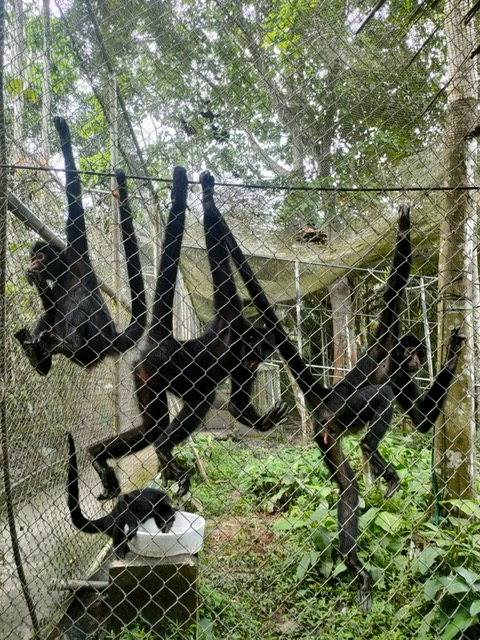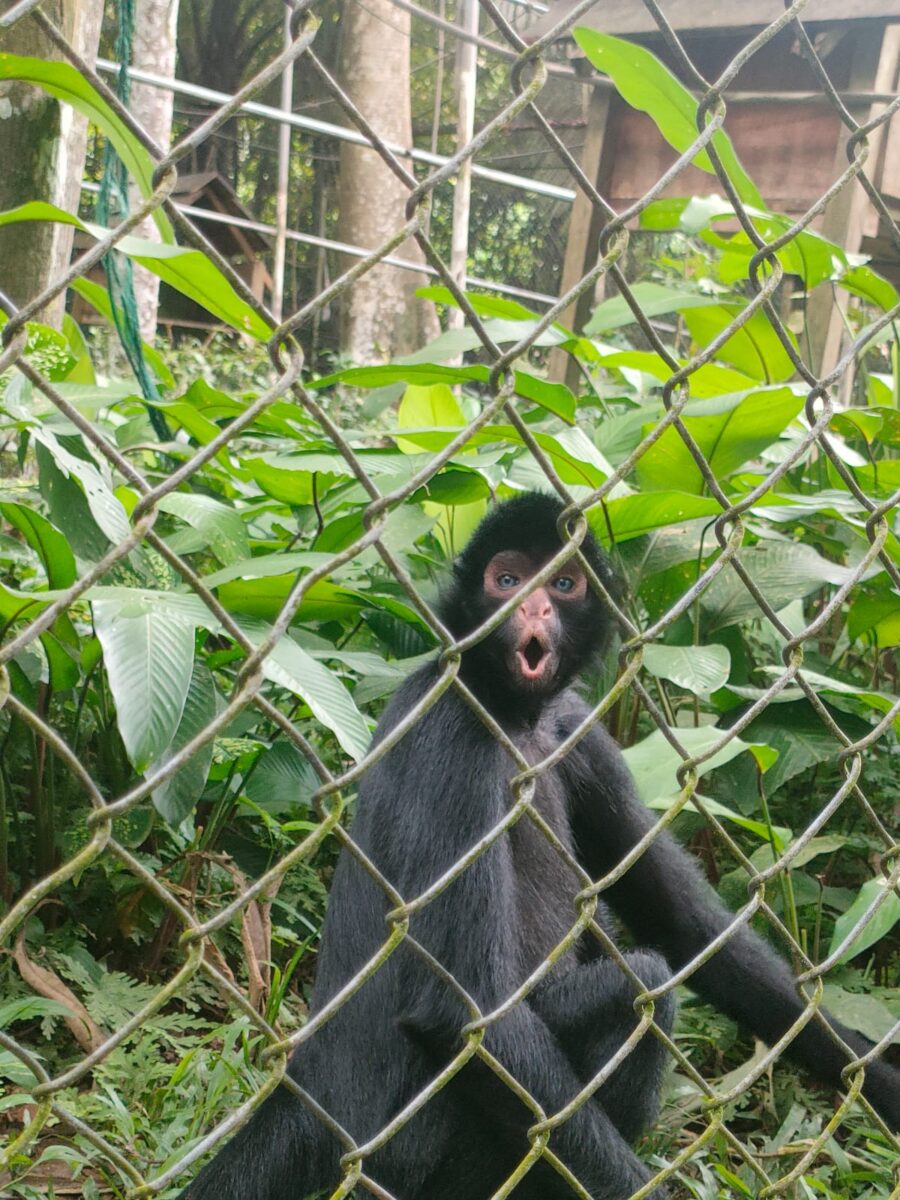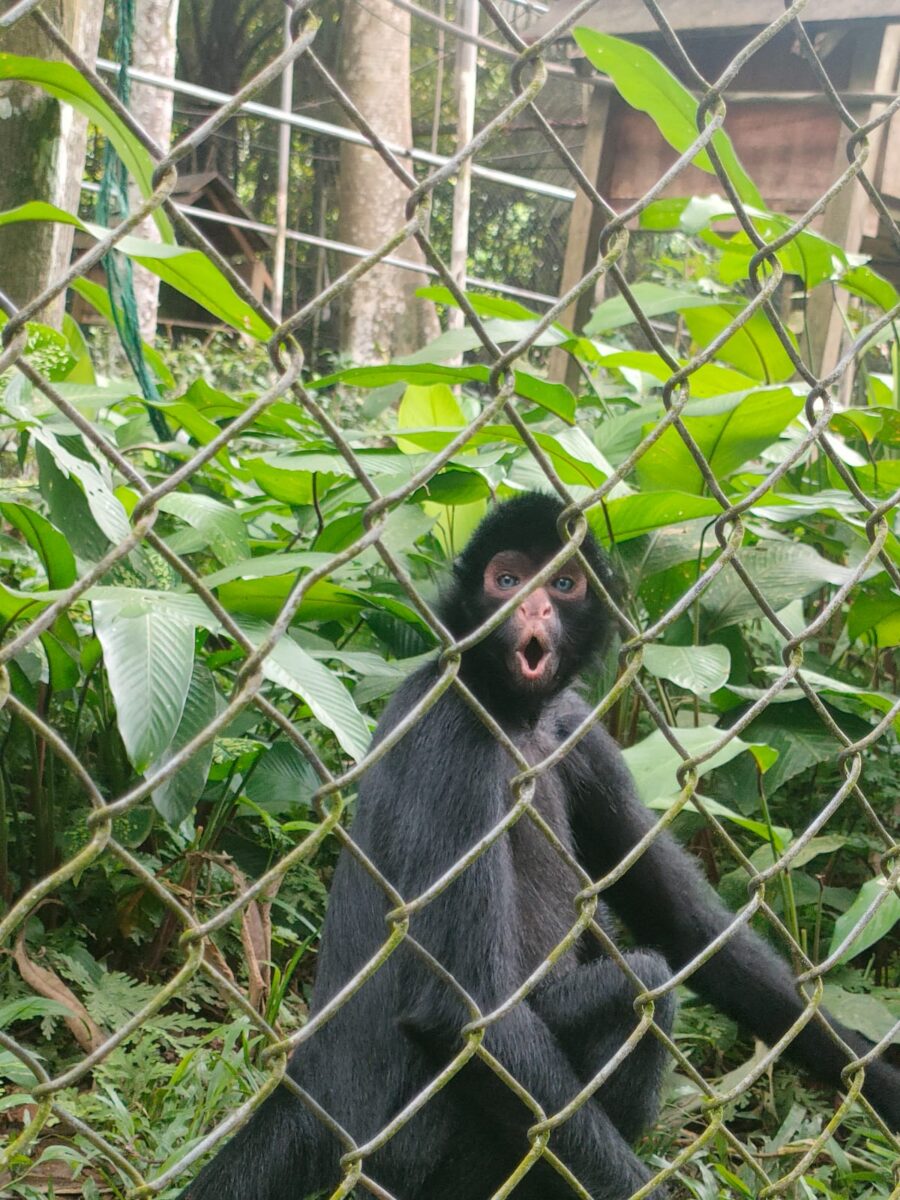
Spider-monkeys, one of the largest primates in the Americas and a frequent sight seen across growing “exotic pet trends” and entertainment. These highly intelligent and social creatures are often found in troops of up to 30 individuals, however, there has been groups recorded with having over 100 members in the wild.
The spider monkey has very long, thin arms with no opposable thumb – instead a hooklike hand that allows them to swing through the trees. The long limbs, with the occurrence of walking on two legs and common behaviour of hugging one another. Embracing each other and wrapping themselves around others makes them seem “cute” and “cuddly” – these desired traits are idolised for those wanting exotic pets. Unfortunately, spider monkeys are under threat from hunting and trapping – these wild animals are not pets. nor will they make good pets, they need stimulation – large groups and social connections- a huge territory and canopy to browse for fruits. They are not here for our entertainment and suffer in captivity.
During the days, these monkeys search for fruit which is the main part of their diet. While they also observed eating sees, flowers, barks, leaves, and small insects during the dry season when the fruit is not always available. These omnivores are incredibly intelligent, recognizing seasonal differences in the forests that they call home – having robust memories of where to find fruits and paths through the canopy.
The name Spider-monkey comes from the similarities they share with the arachnids when they drop from trees, upside and hang from their tails with arms and legs dangling – resembling a sort of spider shape. Their genus name is Atelese – the origin meaning “imperfect” which refers to the fact they do not have opposable thumbs.
There are seven species of spider monkeys, which are wild populations are largely concentrated in Brazil, Columbia, Venezuela, Ecuador, and Peru. The individuals that ate refuge at Pilpintuwasi are all victims of the illegal wildlife trade. Several of the spider monkeys were tied with short metal chains to the floor of a garage in Lima, immobile and used as entertainment as pets. The troop we have were rescued by Animal Defenders International (ADI) which works with varying animal welfare cases and conservation practices. They were brought to our center where they are now cared for by Nils, they have just one worker dedicated to their care – they have been traumatized and it is paramount we do not stress them further.
One spider-monkey in our care is easily distinguished from the others, we gave her the name Valeria as she bared the eyes of the ‘white walkers’ seen in the popular TV show ‘Game of Thrones’. Her eyes are a breathtaking pale blue, this is a very rare phenotype seen in primates, in fact only three species in the world display this trait – humans being one, spider monkeys, and one species of lemur. Valeria is a brown-spider monkey, one of the most endangered primates in the Neotropics, and has been listed six times on the ‘World’s 25 Most Endangered Primates” list. This unusual eye color can be seen in less than 13% of the wild spider monkey population found in Columbia, the blue-iris mutation, unfortunately, makes them more desirable to hunting – a rare mutation that could be a death sentence due to the human greed and desire to collect natures treasures.

Los monos araña, uno de los primates más grandes de América, se ven con frecuencia en las crecientes “tendencias de mascotas exóticas” y en el mundo del espectáculo. Estas criaturas altamente inteligentes y sociales suelen encontrarse en grupos de hasta 30 individuos, aunque se han registrado grupos con más de 100 miembros en libertad.
El mono araña tiene brazos muy largos y delgados, sin pulgar oponible, sino una mano en forma de gancho que le permite balancearse entre los árboles. Las largas extremidades, con la ocurrencia de caminar sobre dos patas y un comportamiento común de abrazarse unos a otros. Abrazarse y envolverse alrededor de los demás les hace parecer “monos” y “mimosos” – estos rasgos deseados son idolatrados por quienes desean mascotas exóticas. Desgraciadamente, los monos araña están amenazados por la caza y las trampas. Estos animales salvajes no son animales de compañía, ni serán buenas mascotas. Necesitan estímulos, grupos grandes y relaciones sociales, un territorio enorme y un toldo donde buscar frutos. No están aquí para nuestro entretenimiento y sufren en cautividad.
Durante el día, estos monos buscan fruta, que es la parte principal de su dieta. Aunque también se les observa comer ve, flores, cortezas, hojas y pequeños insectos durante la estación seca, cuando no siempre hay fruta disponible. Estos omnívoros son increíblemente inteligentes, reconocen las diferencias estacionales en los bosques que consideran su hogar y tienen una gran memoria para encontrar frutas y caminos entre las copas de los árboles.
El nombre de mono araña proviene de las similitudes que comparten con los arácnidos cuando se dejan caer de los árboles, boca arriba y colgando de la cola con los brazos y las piernas colgando – asemejándose a una especie de forma de araña. Su nombre genérico es Atelese, cuyo origen significa “imperfecto”, en referencia al hecho de que no tienen pulgares oponibles.
Hay varias especies de monos araña, cuyas poblaciones salvajes se concentran principalmente en Brasil, Colombia, Venezuela, Ecuador y Perú. Los ejemplares que se refugiaron en Pilpintuwasi son todos víctimas del comercio ilegal de animales salvajes. Varios de los monos araña estaban atados con cortas cadenas metálicas al suelo de un garaje de Lima, inmóviles y utilizados como entretenimiento como mascotas. La tropa que tenemos fue rescatada por Animal Defenders International (ADI), que trabaja con diversos casos de bienestar animal y prácticas de conservación. Los trajeron a nuestro centro, donde ahora los cuida Nils, y sólo tienen un trabajador dedicado a su cuidado: están traumatizados y es primordial no estresarlos más.
Una de las monas araña que cuidamos se distingue fácilmente de las demás. Le pusimos el nombre de Valeria porque tiene los ojos de los caminantes blancos que aparecen en la popular serie de televisión “Juego de Tronos”. Sus ojos son de un azul pálido impresionante, un fenotipo muy poco común en los primates; de hecho, sólo tres especies en el mundo presentan este rasgo: los humanos, los monos araña y una especie de lémur. Valeria es un mono araña marrón, uno de los primates más amenazados del Neotrópico, que ha sido incluido seis veces en la lista de los “25 primates más amenazados del mundo”. Este inusual color de ojos se puede ver en menos del 13% de la población de monos araña salvajes de Colombia. Por desgracia, la mutación del iris azul los hace más apetecibles para la caza, una rara mutación que podría ser una sentencia de muerte debido a la codicia y el deseo de los humanos de coleccionar tesoros de la naturaleza.
